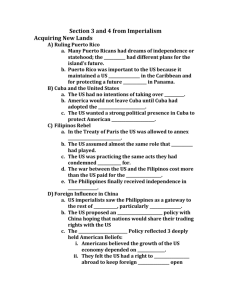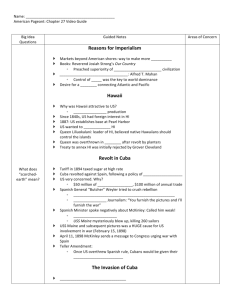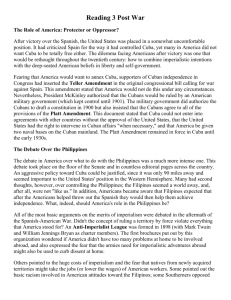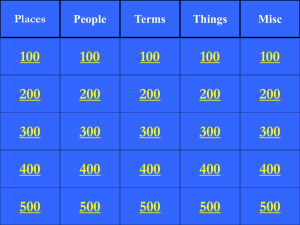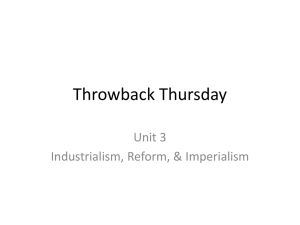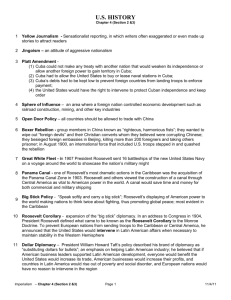Ch 27 Empire and Expansion
advertisement
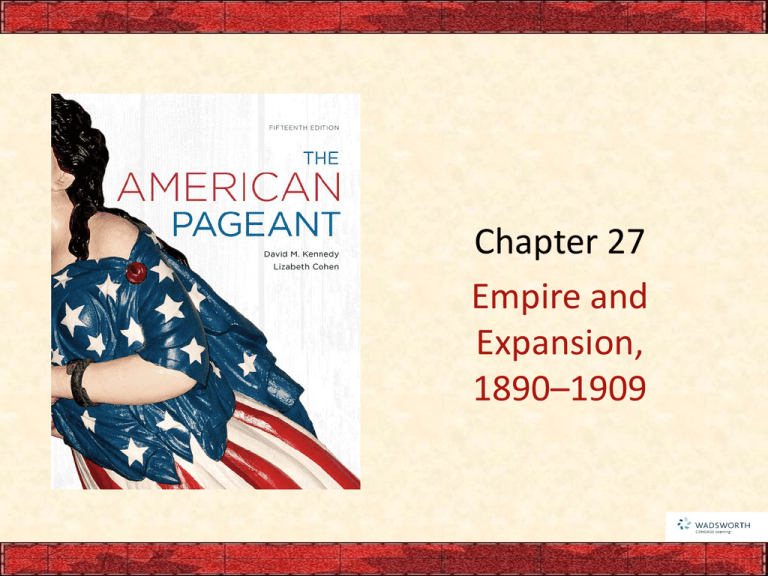
Chapter 27 Empire and Expansion, 1890–1909 I. America Turns Outward – Many developments fed the nation’s ambition for overseas expansion: • Farmers and factory owners to look beyond American shores as agricultural and industrial production increased • Many believed America had to expand or explode • Country bursting from growth in population, wealth, and productive capacity • The lurid “yellow press” described foreign exploits as manly adventures • Pious missionaries looked overseas for new souls inspired by Josiah Strong’s Our Country: Its Possible Future and Its Present Crisis. America Turns Outward (cont.) • Aggressive Americans were interpreting Darwinism to mean that the earth belonged to the strong and the fit—that is, Uncle Sam—Theodore Roosevelt and Henry Cabot Lodge – America would have to become an imperial power • The development of a new steel navy focused attention overseas: – Supported by Captain Alfred Thayer Mahan’s The Influence of Sea Power upon History, 1660-1783. – America’s new international interest manifested itself in several ways: America Turns Outward (cont.) • Big Sister policy: – Pushed by Secretary of State James G. Blaine: – Aimed at rallying the Latin America nations behind Uncle Sam’s leadership – Opening Latin American markets to Yankee traders – Blaine presided over the first Pan-American Conference: » The modest beginnings of important series of interAmerican assemblages • Diplomatic crises that marked the path of American diplomacy in late 1880s and early 1890s: – American and German navies nearly came to blows in 1889 over the Samoan Islands in the South Pacific – The lynching of 11 Italians in New Orleans (1891) brought America and Italy to the brink of war America Turns Outward (cont.) – American demands on Chile after the death of two American sailors in 1892 in the port of Valparaiso made hostilities between the two countries seem inevitable – An argument between the United States and Canada over seal hunting near the Pribilof Islands, off the coast of Alaska • Series of crises between the United States and Great Britain in 1885-1886: – Border dispute between British Guiana and Venezuela: » Richard Olney, Secretary of State, became involved, even to the point of alerting US naval power » Cleveland urged Congress for an appropriation for a commission to draw the line » Fortunately second thoughts avoided war. – Great Rapprochement—reconciliation between the United States and Great Britain. p609 p610 II. Spurning the Hawaiian Pear • Hawaii was an early attraction for Americans: – A way station and provisioning point for Yankee shippers, sailors, and whalers – In 1820 early missionaries arrived preaching: • Protestant Christianity • Protective calico – Hawaii became an important center for sugar production. – Americans came to regard Hawaii as an extension of their own coastline. II. Spurning the Hawaiian Pear (cont.) • McKinley Tariff: • Raised barriers against Hawaiian sugar • White planters renewed their efforts to secure the annexation of Hawaii to the United States • Blocked by the strong-willed Queen Liliuokalani: – Insisted that native Hawaiians should control the islands – Few whites organized a successful revolt early 1893 with the open assistance of American troops • A treaty of annexation was rushed to Washington, stopped by the presidential change in the United States: – President Cleveland abruptly withdrew the treaty. II Spurning the Hawaiian Pear (cont.) • The Hawaiian pear continued to ripen until the United States acquired its overseas empire in 1898 (see May 27.1). Map 27-1 p611 p612 III. Cubans Rise in Revolt • Cuba’s masses rose against their Spanish oppressors in 1895: – The roots of the revolt were partly economic: • Sugar production was crippled by the American tariff (1894) that restored high duties: • Cubans adopted a scorched-earth policy: – The insurrectos torched canefields and sugar mills and dynamited passenger trains – Their destructive tactics menaced American interests on the island. Cubans Rise in Revolt (cont.) – American sympathies went out to Cuba underdogs: • American business investments of $50 million in Cuba • Annual trade of $100 million • Possibility of a much-anticipated Panama Canal. – Fuel added by the arrival of the Spanish general “Butcher” Weyler: • He undertook to crush the rebellion: » By herding many citizens into barbed-wire reconcentration camps » Where they could not give assistance to the armed insurrectos. Cubans Rise in Revolt (cont.) – Atrocities were red meat for the sensational new “yellow journalism” of Hearst and Pulitzer – Early in 1898 Washington sent the battleship Maine to Cuba for a “friendly visit”: • Actually to protect and evacuate Americans – Tragedy struck, February 15, 1898, when the Maine mysteriously blew up in Havana harbor, loss of 260 sailors: – Two investigations resulted: » The Spaniards concluded that the explosion had been internal and presumably accidental » The Americans argued that the blast had been caused by a submarine mine. Cubans Rise in Revolt (cont.) – U.S. Naval admiral H.G. Rickover in 1976 confirmed the original Spanish findings • But Americans in 1898 continued their explanation: – Washington demanded: » An end to the reconcentration camps » An armistice with Cuban rebels. • McKinley in a jam: – Did not want hostilities, but neither did he want Spain to remain in possession of Cuba – Did not want a fully independent Cuba, over which the United States could exercise no control – “Wobby Willie” recognized the inevitable, eventually gave the people what they wanted Cubans Rise in Revolt (cont.) • He acknowledged America’s commercial and strategic interest in Cuba: – On April 11, 1898, McKinley sent his war message to Congress – Urging armed intervention to free the oppressed Cubans – The legislators responded uproariously with what was essentially a declaration of war – They adopted the hand-tying Teller Amendment— » This proviso proclaimed to the world that when the United States had overthrown Spanish misrule, it would give the Cubans their freedom » A declaration that caused imperialistic Europeans to smile skeptically p613 IV. Dewey’s May Day Victory at Manila • The American people plunged into the war lightheartedly: – The declaration of war, February 25, 1898: • Navy Secretary John D. Long was away from the office • Theodore Roosevelt took things into his own hands: – He cabled Commodore George Dewey to descend upon Spain’s Philippines in the event of war – President McKinley confirmed Roosevelt’s instructions – Dewey carried out his orders magnificently on May 1, 1898 (see Map 27.2). IV. Dewey’s May Day Victory at Manila (cont.) – On August 13, 1898, long-awaited American troops arrived: • Assisting Dewey to complete the war • Also assisted by Emilio Aguinaldo • The Manila episode renewed the United States’ focus on Hawaii: – A joint resolution of annexation of Hawaii was rushed through Congress – Approved by McKinley on July 7, 1898 – It granted Hawaiian residents U.S. citizenship – Hawaii received full territorial status in 1900. Map 27-2 p614 V. The Confused Invasion of Cuba • Invasion of Cuba: • The Spanish government ordered a fleet to Cuba • Panic seized the eastern seaboard of the United States • The Spanish “armada” eventually landed in Santiago harbor, Cuba: – Where it was blockaded by the powerful American fleet – General William R. Shafter was sent in to assist • The Rough Riders, a part of the invading army, now charged onto the stage of history V. The Confused Invasion of Cuba (cont.) – The Rough Riders: • Regiments of volunteers, consisted largely of western cowboys and other hardy characters • Commanded by Colonel Leonard Wood • The group was organized principally by glory-chasing Theodore Roosevelt • On July 1 at El Caney and Kettle Hill Colonel Roosevelt and his horseless Rough Riders charged • Shafter’s having landed near Santiago now spelled doom for the badly outgunned Spanish fleet: – Shortly after a few mishaps by the Spanish, they surrendered (see Map 27.3). V. The Confused Invasion of Cuba (cont.) – Spain on August 12, 1898, signed an armistice: • If the Spaniards had held a little longer in Cuba, the American army might have melted away. • The inroads of malaria, typhoid fever, dysentery, and yellow fever became so severe that hundreds were incapacitated –“an army of convalescents.” • Other suffered from eating malodorous canned meat known as “embalmed beef.” • All told, nearly four hundred men lost their lives to bullets • Over five thousand succumbed to bacteria and other causes. p615 p616 Map 27-3 p616 VI. America’s Course (Curse?) of Empire – 1898 Spanish and American negotiators met in Paris: • Cuba was freed from its Spanish overlords • Americans secured the remote Pacific island of Guam • Spain ceded Puerto Rico to the United States as payment for war costs – Ironically, the last remnant of Spain’s vast New World empire thus became the first territory ever annexed to the United States without the express promise of eventual statehood. – Puerto Rican immigrants impact of the United States (see pp. 618-619). America’s Course (Curse?) of Empire (cont.) – Knottiest of all was the problem of the Philippines: • Contained an ethnically diverse population of 7 millions • McKinley’s dilemma of what to do with the Philippines – Final conclusion: » Was to acquire all the Philippines » Then perhaps give the Filipinos their freedom later. • Protestant missionaries were for new converts from Spanish Catholicism. America’s Course (Curse?) of Empire (cont.) • Wall Street was clamoring for profits in the Philippines. – McKinley decided outright annexation of the islands: • Question what to do about Manila since it was taken after the armistice was signed • The deadlock was broken by agreeing to pay Spain $20 million for the Philippine Islands—the last great Spanish haul from the New World. • The signing of the pact of Paris touched off one of the most impassioned foreign-policy debates in American history. America’s Course (Curse?) of Empire (cont.) • What about the Filipinos’ national identity? – National identity: • A distant tropical area • Thickly populated by Asians of a different culture, tongue, and government institutions: • Annexation? – Opponents: a step that would dishonor and ultimately destroy America’s venerable commitments to selfdetermination and anticolonialism – Proponents: would continue a glorious history of expansion that had pushed American civilization to the Pacific and beyond. America’s Course (Curse?) of Empire (cont.) – The Anti-Imperialist League: • Sprang into being to fight the McKinley administration’s expansionist moves: • Included the most prominent people in the United States, including the presidents of Harvard and Stanford, and Mark Twain • Also labor leader Samuel Gompers and Andrew Carnegie. – Anti-imperialists raised many objections: • The Filipinos thirsted for freedom: – To annex them would violate the “consent of the governed”-Declaration of Independence and Constitution. America’s Course (Curse?) of Empire (cont.) • Despotism abroad might well beget despotism at home • Imperialism was costly and unlikely to turn a profit • It would propel the United States into the political and military cauldron of East Asia. – In short, the wealthy Americans must help to uplift (and exploit) the underprivileged, underfed, and underclad of the world • Over heated protests, the Senate approved the treaty with Spain with just one vote to spare on February 6, 1899 • American was now officially an empire. p617 p618 p619 p619 VII. Perplexities in Puerto Rico and Cuba • The status of Puerto Rico was anomalous— – Neither a state nor a territory – With little prospect of eventual independence. – The Foraker Act (1900): • Accorded Puerto Rico a limited degree of popular government • Congress granted U.S. citizenship in 1917 • But withheld full self-rule – The annexation of Puerto Rico posed a thorny legal problem. VII. Perplexities in Puerto Rico and Cuba (cont.) – The Insular Cases: • That Puerto Ricans (and Filipinos) might be subject to American rule, but they did not enjoy all American rights • Cuba under American leadership wrought miracles in all areas of Cuban life. • Under the Teller Amendment the United States withdrew from Cuba in 1902 • The Cubans were forced to write into their own constitution (1901) the so-called Platt Amendment. VII. Perplexities in Puerto Rico and Cuba (cont.) • The Platt Amendment: • Served McKinley’s ultimate purpose of bringing Cuba under American control: – “Plattism” survives as a colloquial term of derision even in modern-day Cuba. • They were forced to agree not to conclude treaties that might compromise their independence • Not to take on debt beyond their resources (as Uncle Sam measured them) • Further that the United States might intervene with troops to restore order when it saw fit VII. Perplexities in Puerto Rico Cuba (cont.) • The Cubans promised to sell or lease needed coaling or naval stations, ultimately two and then only one: (Guantánamo) to their powerful “benefactor.” – The United States finally abrogated the amendment in 1934 – The United States still occupies a 28,000-acre Cuban beachhead at Guantanamo under an agreement that can be revoked only by the consent of both parties (see pp.779-780). VIII. New Horizons in Two Hemispheres – The Spanish-American War was a kind of colossal coming-out party: • • • • The war was short (113 days) Low in casualties Theatrically successful Despite Secretary of State John Hay calling it a “splendid little war” • American prestige rose sharply • Europeans grudgingly accorded the Republic more respect • Britain, France, Russia and other great powers upgraded their legations in Washington, D.C. VIII. New Horizons in Two Hemispheres (cont.) • An exhilarating new martial spirit thrilled America • John Philip Sousa, newly popular military marching band music • Most Americans did not start the war with consciously imperialistic motives • Secretary of War Elihu Root established a general staff for the army and founded the War College in Washington: • One of the most beneficial results was the further closing of the “bloody chasm” between North and South. VIII. New Horizons in Two Hemispheres (cont.) • The newly imperial nation was: • Not yet prepared to pay the full bill for its new states • By taking on the Philippines Island, the United States became a full-fledged Far Eastern power • But the distant islands eventually: • Became a “heel of Achilles,” a kind of indefensible hostage given to Japan, World War II. • Here and elsewhere: • The Americans had shortsightedly assumed burdensome commitments that they proved unwilling to defend with appropriate naval and military outlays. IX. “Little Brown Brothers” in the Philippines – Disappointed Filipinos: • Assumed they would be granted their freedom after the Spanish-American War • Washington excluded them from the peace negotiations with Spain • Made its intentions to stay in the Philippines indefinitely • Bitterness toward American troops erupted on February 4, 1899, under Emilio Aguinaldo • United States was forced to deploy 126,000 troops ten thousand miles away. IX. “Little Brown Brothers” in the Philippines (cont.) • Now the Filipinos were viewed as a dangerous enemy – This shift contributed to a mounting “race war”: • Both sides perpetrated sordid atrocities: – “water cure” forcing water down victims throats until they yielded information or died – American built reconcentration camps – American broke the backs of the Filipinos insurrection (1901): » They captured Aguinaldo » Claiming 4,234 Americans and as many as 600,000 Filipinos. IX. “Little Brown Brothers” in the Philippines (cont.) – William H. Taft became civil governor of the Philippines in 1901: • Because of his attachment to them, he called them his “little brown brothers” • McKinley’s “benevolent assimilation” proceeded slowly • Washington poured in millions to improve the country, which was ill-received • The Filipinos hated compulsory Americanization and pined for liberty • They were finally granted their freedom on the Fourth of July, 1946 and many migrated to the US (see pp. 624-625). p622 X. Hinging the Open Door in China • After China’s defeat by Japan in 1894-1895 – The imperialistic European powers—Russia and Germany—moved in: • A growing group of Americans viewed the vivisection of China with alarm – Churches worried about their missionary strongholds – Merchants feared that Europeans would monopolize Chinese markets – There were demands that Washington do something: » Secretary of State John Hay decided upon a dramatic move. X. Hinging the Open Door in China (cont.) – Open Door note: dispatched by Hay in 1899 to all the great powers: • He urged them to announce that in their leaseholds or spheres of influence: – They would respect certain Chinese rights – And the ideal of fair trade – Hay had not bothered to consult the Chinese themselves • The phrase Open Door – Quickly caught the American public’s fancy – It caused much squirming in the leading capitals of the world: » Though all the great powers save Russia, with covetous designs on Manchuria, eventually agreed to it. X. Hinging the Open Door in China (cont.) • Patriotic Chinese did not care to be used as a doormat by the Western power – In 1900 a superpatriotic group, the “Boxers,” broke loose with the cry “Kill Foreign Devils” – In the Boxer Rebellion » they murdered more than 200 foreigners and thousands of Chinese Christians » Besieged the foreign diplomatic community in the capital Beijing (Peking). » A multinational rescue force of thousands of soldiers arrived and quelled the rebellion » They included several thousand American troops dispatched from the Philippines to protect U.S. rights under the 1844 Treaty of Wanghia (see p. 390) and to keep the Open Door propped open. X. Hinging the Open Door in China (cont.) – Results of the Boxer Rebellion: • The Chinese were assessed an indemnity of $333 million: – Of which American share was to be $24.5 million – Since the amount was more than necessary, the U.S. remitted about $18 million to be used for the education of a selected group of Chinese students in the U.S.—a not-sosubtle-initiative to further the westernization of Asia. • Secretary Hay released another set of papers in 1900: – Henceforth the Open Door would embrace the territorial integrity of China, in addition to its commercial integrity – These were incorporated into the Nine-Powers Treaty of 1922, violated by Japan’s takeover of Manchuria (see pp. 731 and 747). p623 p624 p625 p625 p626 XI. Imperialism or Bryanism in 1900? – McKinley was renominated by Republicans in 1900 because: • Had won a war and acquired rich, though burdensome, real estate • Had safeguarded the gold standard • Had brought promised prosperity. • Theodore (“Teddy”) Roosevelt (TR) was selected vice presidential candidate. – William Jennings Bryan was the odds-on choice of the Democrats, meeting in Kansas City: • Their platform proclaimed that the paramount issue was Republican overseas imperialism. XI. Imperialism or Bryanism in 1900? – Campaigning: • McKinley, the soul of dignity, once again campaigned safely from his front porch. • Brian again took to the stump in a cyclonic campaign. • Roosevelt out-Bryaned Bryan, touring the country with revolver-shooting cowboys: – He denounced all dastards who would haul down Old Glory. – Election results: – McKinley triumphed by a much wider margin than in 1896: 7,218,491 to 6,356,734 popular votes: – 292 to 155 electoral votes. XI. Imperialism or Bryanism in 1900 (cont.) – Victory for the Republicans: • Was not a mandate for or against imperialism • If there was a mandate, it was for two Ps: – Prosperity and protectionism. • Meanwhile the New York bosses gleefully looked forward to watching the nettlesome Roosevelt “take the veil” as vice president. XII. TR: Brandisher of the Big Stick – William McKinley was murdered in September 1901 by a deranged anarchist in Buffalo, N.Y. – Roosevelt assumed the presidency at age 42, the youngest president thus far: • The Rough Rider with high-voltage energy was electrifying • Preached the virile virtues and denounced pacifistic “flubdubs” and “mollycoddles” • Was an ardent champion of military and naval preparedness • He adopted as his pet proverb, “Speak softly and carry a big stick, [and] you will go far.” XII. TR: Brandisher of the Big Stick (cont.) – He loved people and mingled with those of all ranks: • From Catholic cardinals to professional prizefighters, – One of whom blinded a Rooseveltian eye in a White House bout. • “TR” commanded an idolatrous personal following • He believed that the president should lead boldly • He had no real respect for the delicate checks and balances among the three branches of government • The president, he felt, may take any action in the general interest that is not specifically forbidden by the laws of the Constitution. p627 XIII. Building the Panama Canal – Roosevelt soon applied his bullish energy to foreign affairs: • Spanish American war reinvigorated interest in the canal across the Central American isthmus • Took the battleship Oregon, stationed on the Pacific Coast, weeks to steam around South America to join the U.S. fleet in Cuban waters • Such a waterway would make it easier to defend new acquisitions as Puerto Rico, Hawaii, and the Philippines – While facilitating the operations of the U.S. merchant marine. XIII. Building the Panama Canal (cont.) • Initial obstacles were legal rather than geographical: – The terms of the Clayton-Bulwer Treaty, concluded with Britain in 1850, the United States could not secure exclusive control over the isthmian route – By 1901 America’s British cousins were willing to yield – Britain was willing to consent to the Hay-Pauncefote Treaty: » It gave the United States a free hand to build the canal » And conceded the right to fortify it. • Why should the canal be built? – American experts favored a route across Nicaragua – But agents of the old French Canal Company were eager to salvage their costly failure at S-shaped Panama – Philippe Bunau-Varilla of the New Panama Company dropped the price from $109 million to the fire-sale of $40 million. XIII. Building the Panama Canal (cont.) • Congress June 1902 finally decided on the Panama route: – The Columbia senate rejected an American offer of $10 million and annual payment of $250,000 for a six-mile-wide zone across Panama – Roosevelt railed against those who were frustrating his ambitions – Meanwhile, impatient Panamanians were ripe for another revolt: • They had counted on a wave of prosperity to follow construction of the canal XIII. Building the Panama Canal (cont.) • And they feared that the United States would now turn to the Nicaraguan route • Scheming Bunau-Varilla was no less disturbed by the prospect of losing the company’s $40 million • He helped incite a rebellion in November 3, 1903 • U.S. naval forces prevented Colombian troops from crossing the isthmus to quell the uprising • Roosevelt moved rapidly to make steamy Panama a virtual outpost of the United States – Three days after the insurrection, he hastily extended the right hand of recognition. – Fifteen days later Bunau-Varilla signed the Hay-BunauVarilla Treaty in Washington. XIII. Building the Panama Canal (cont.) – The price of the canal was left the same: » But the zone was widened from six to ten miles – The French company gladly pocketed its $40 million from the U.S. Treasury. • Roosevelt did not actively plot to tear Panama from the side of Columbia: – Conspirators knew of his angrily expressed views – They counted on him to use his big stick to hold Columbia at bay – His involvement did leave the impression that he had been a secret party to the intrigue – And thus the so-called rape of Panama marked an ugly downward lurch in U.S. relations with Latin America. XIII. Building the Panama Canal (cont.) • Construction began in 1901: – There were daunting difficulties ranging from labor troubles to landslide to lethal tropical diseases – Colonel William C. Gorgas: » The quiet and determined exterminator of yellow fever in Havana » Ultimately made the Canal Zone “as safe as a health resort.” – At the cost of some $400 million – An autocratic West Point engineer, Colonel George Washington Goethals, ultimately brought the project to completion in 1914, just as World War I was breaking out. p628 XIV. TR’s Perversion of Monroe’s Doctrine – Latin American debt defaults prompted Roosevelt to get involved: • Venezuela and the Dominican Republic were chronically in arrears to European creditors • Germany actually bombarded a town in delinquent Venezuela in 1803 • Roosevelt feared that the Germans or British might remain in Latin America, in violation of he Monroe Doctrine • The Roosevelt Corollary to the Monroe Doctrine: a brazen policy of “preventive intervention” XIV. TR’s Perversion of Monroe’s Doctrine (cont.) • He announced that in the event of further financial troubles in Latin America, the U.S. itself: – – – – Would intervene Take over the customhouses Pay off the debts Keep the troublesome Europeans on the other side of the Atlantic • In short, no outsiders could push around the Latin nations, except Uncle Sam, policeman of the Caribbean: – The big stick in the Caribbean became effective in 1905 – When the U.S. took over tariff collection in the Dominican Republic, formalized two years later. XIV. TR’s Perversion of Monroe’s Doctrine (cont.) – TR’s rewriting of the Monroe Doctrine did more to promote the “Bad Neighbor” policy: • It was used to justify wholesale interventions • Repeated landings of the marines • All of which helped turn the Caribbean into a “Yankee lake” • To Latin America it seemed like a cloak behind which the U.S. sought to strangle them • The shadow of the big stick fell again on Cuba, 1906: – Revolutionary disorders brought an appeal from the Cuban president and “necessity being the mother of intervention,” U.S. Marines landed, to be withdrawn in 1909 – Seen as the creeping power of the Colossus of the North. p629 XV. Roosevelt on the World Stage • Roosevelt charged into international affairs: – The outbreak of the war between Russia and Japan (1904) to perform as a global statesman: • Russia wanted into the ice-free ports of China’s Manchuria, particularly Port Arthur • To Japan, Manchuria and Korea in tsarist hands were pistols pointed at Japan’s strategic heart • The Japanese responded in 1904 with a devastating surprise pounce on the Russian fleet at Port Arthur • They proceeded to administer a humiliating series of beatings to the inept Russians XV. Roosevelt on the World Stage (cont.) • This was the first serious military setback to a major European power by a non-European force since the Turkish invasions of the 16th century • Tokyo secretly sought U.S. help to sponsor peace negotiations • Roosevelt was happy to oblige: – At Portsmouth, New Hampshire, 1906, TR guided the warring parties to a settlement that satisfied neither side and left the Japanese, who felt they won the war, resentful: » Japan was forced to drop its demands for a cash indemnity » Russia evacuated the Sakhalin Island. XV. Roosevelt on the World Stage (cont.) • TR received the Nobel Peace Prize in 1906: – For his negotiations between Russia and Japan • But the price of his diplomatic glory was high for U.S. foreign relations • U.S. relations with Russia soured when they accused him of robbing them of military victory • Revelations of savage massacres of Russian Jews further poisoned American feelings against Russia • Japan felt cheated out of its due compensation • Both newly powerful, Japan and America now became rivals in Asia, as fear and jealousy between them grew (see pp. 632-633). XVI. Japanese Laborers in California – America’s Pacific Coast soon felt the effects of the Russo-Japanese War: • New wave of Japanese immigrants poured into California • Only 3% of state’s population, still white Californians ranted about a new “yellow peril” and fear of being drowned in an Asian sea: • Showdown came in 1906 when the San Francisco’s school board ordered the segregation of Chinese, Japanese, and Korean students in a special school to free more space for whites: – It boiled into an international crisis; people of Japan regarded the discrimination as an insult. XVI. Japanese Laborers in California (cont.) • Irresponsible war talks sizzled on both side of the Pacific – Roosevelt invited the SF mayor, board of education to the White House – TR finally broke the deadlock » Californians were induced to repeal the offensive school order » Became known as the “Gentlemen’s Agreement” » Tokyo agreed to stop the flow of laborers to the American mainland by withholding passports. – Roosevelt’s dramatic scheme was to send the entire battleship fleet on a highly visible voyage around the world: » Late in 1907 16 sparkling-white, smoke-belching battleships started from Virginia XVI. Japanese Laborers in California (cont.) – Commander declared that he was ready for “a feast, a frolic, or a fight” – The Great White Fleet received tumultuous welcomes in Latin America, Hawaii, New Zealand, and Australia – The overwhelming reception in Japan was the high point of the trip – Tens of thousands of kimonoed schoolchildren, trained to wavy tiny American flags, movingly sang “The Star-Spangled Banner” – The U.S. signed the Root-Tarahira agreement with Japan in 1908: » It pledged both powers to respect each other’s territorial possessions in the Pacific » And to uphold the Open Door in China. – For the moment, the two powers found a means to peace. p631 p632 Map 27-4 p633 p635



